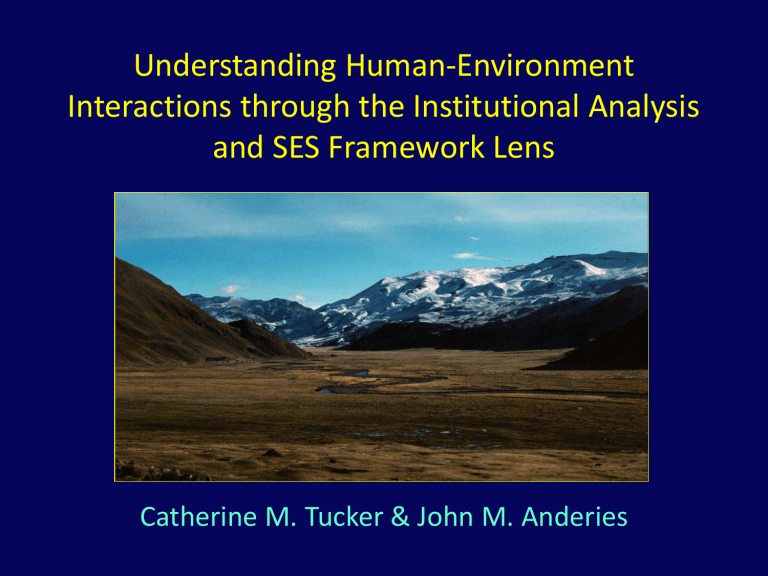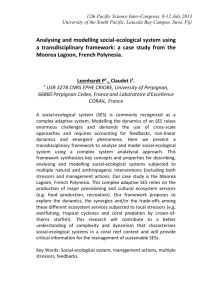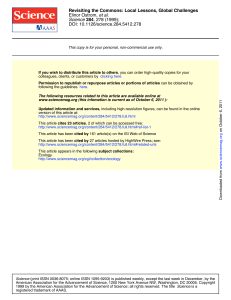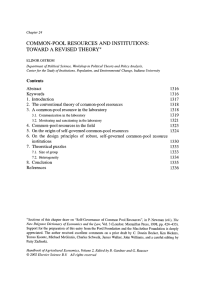Understanding Human-Environment Interactions through the Institutional Analysis and SES Framework Lens

Understanding Human-Environment
Interactions through the Institutional Analysis and SES Framework Lens
Catherine M. Tucker & John M. Anderies
Central Issues
•
Over-use and degradation of natural resources threatens the future viability of human societies and mountain systems as we know them
•
Understanding processes and proposing effective policies is difficult: mountains are complex social-ecological systems often with multiple jurisdictions, numerous interested parties, competing uses, inadequately understood ecological relationships, and overlapping (sometimes contradictory) rules and management practices
•
How to move toward sustainable management of mountain systems?
•
Key concepts: Common-pool Resources, Social-ecological systems, Institutions, and Frameworks
Conundrums of Common-Pool
Resources (CPRs)
•
Common-pool resources (CPRs) include renewable natural resources (forests, fisheries…) and certain other resources (the internet)
•
Governing CPRs sustainably poses immense challenges
•
Common-pool resources have two distinguishing characteristics:
–
Exclusion is difficult or costly (it’s hard to keep people out)
–
Subtractability (they are subject to degradation)
•
CPRs are part of complex social-ecological systems (SESs), such as mountain systems
Examples of CPR Problems in
Mountains of the Western USA
•
Urban encroachment on fragile mountain slopes and on delicate watersheds
•
Managing competing interests of ranchers, loggers, hunters, tourists, developers, mining companies, conservationists
•
Allocation of water (ground and surface) among competing humans and natural species
•
Governing “amenity values” – “nature” and “wilderness” vs. comfort & convenience for tourists/immigrants
How to Govern CPRs?
•
Conventional perspective:
–
“Tragedy of the commons” happen unless higher level governments impose rules
–
The dominant option is for national governments to create public or private ownership
•
Alternative perspective:
–
In certain conditions, human groups are able to selforganize and manage CPRs sustainably in local /regional landscapes, which can have social & ecological advantages
–
Well-documented “design principles” recur in longenduring, community-based regimes to manage local – regional CPRs
•
In any case, CPRs require appropriate institutions for effective management: No single solution for governance!
(Ostrom 1990 Governing the Commons; 2005 Understanding Institutional Diversity )
What are “institutions”?
•
Institutions are RULES that specify the “do’s and don’ts” in a given situation
–
What may, what must, or what must not be done
–
Constraints on acceptable behavior in a specific context
–
Institutions are practiced: Rules-in-use
–
Often occur as decision-making arrangements composed of
“…a constellation of rights, rules, conventions (informal codes and agreements) and contracts, supported by an authority structure” (Edwards & Steins 1998)
CPRs often have multiple interested parties with contrasting views. What happens to CPRs depends on institutional arrangements that exist or develop to address a situation.
What are Frameworks?
•
Metatheoretical language useful for comparing theories
•
Incorporate elements & general relationships known to be important for the problem in question
•
Present a general set of relevant variables
•
Allow for a range of theories and hypotheses
•
Offer a common basis for researchers in different disciplines to organize and integrate knowledge
Frameworks for Investigating Complex
Social-Ecological Systems (SESs)
Major frameworks relevant to research and integration of knowledge across the natural and social sciences in mountain environments, with attention to institutional arrangements:
•
Institutional Analysis and Development (IAD) Framework
•
Social Ecological Systems Framework
•
Robustness of Social-Ecological Systems Framework
Institutional Analysis and Development (IAD)
Framework
External Variables
Biophysical
Conditions
Attributes of
Relevant
Human Groups
ACTION
SITUATION
Interactions
Evaluative
Criteria
Rules-in-Use
Outcomes
Adapted from E. Ostrom. Understanding Institutional Diversity 2005:15
Action
Situation
Detail
Ostrom 2005:33
Social Ecological Systems (SES) Framework
Source: Ostrom, E. 2009. A General Framework for Analyzing the Sustainability of Social Ecological
Systems. Science 325: 419-422
Second Tier
Variables in the
SES Framework
> variables known to influence sustainability of social-ecological systems
> not all variables apply to all cases
> researchers assess which variables are relevant for a case
Ostrom, E. 2009
Science 325:419
Robustness Framework
Focus on Institutions & Infrastructure
Anderies, J.M., M.A. Janssen & E. Ostrom 2004 Ecology & Society 9(1):18
Applications of Frameworks to Mountain Systems
•
Assist in formulating and testing questions
•
Provide theoretically relevant sets of variables
–
Flexible, powerful tools
–
Designed to examine complexity
•
Can be applied to specific case studies or comparative analyses
•
Support development of useful models
•
Common frameworks can foster information exchange, data sharing and knowledge accumulation
Modeling: Extending SES to Coupled
Infrastructure Systems (CIS)
Modeling: Extending SES to Coupled
Infrastructure Systems (CIS)
Leading us to:
Overarching Question for the Session Papers
•
What is the relationship between self-organizing regimes for common-pool resources management and complex, multi-scalar, interjurisdictional systems of governance in mountain regions?
Thank you!
Questions and comments are welcome!






